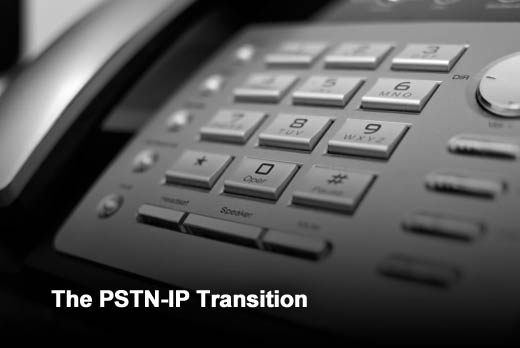In early 2014, among other things, the Federal Communications Commission (FCC) voted to encourage testing the deployment of Internet Protocol (IP) networks in place of long-standing incumbent copper-based networks that have been the foundation of the Public Switch Telephone Network (PSTN). The FCC’s regulatory reform efforts associated with the technological shift toward Internet Protocol (IP) networks and services has come to be known as the PSTN-IP transition. As the FCC manages experiments with IP networks, it is tasked with protecting consumers and stimulating innovation in the process.
The PSTN-IP Transition is an exciting time to be a part of the telecom community. The transition to IP will test our ability to re-imagine the framework for regulating communications services to meet the demands of the marketplace for innovative, next-generation services. According to Bandwidth, in order to fully realize the promise of the PSTN-IP transition, the FCC should remain focused on the following critical points during the evolution: data sets that can be scaled, the ability understand how companies are interrelated, encouraging innovation, transition to HD service, and integration 911 service.
Bandwidth is a communications technology company that’s transforming the way people communicate and challenging the standards of old telecom. Together with their customers, they’re unlocking remarkable value from IP networks, questioning the status quo, and helping people interact with technology and one another, oftentimes in ways they never dreamed possible.
Click through for five factors that will be necessary for a successful IP transition trial by the FCC, as identified by Bandwidth.
Relevant data sets that can be scaled
For data from the experiments to be useful and relevant, it must have integrity and will need to be scalable. Valid and high-volume data will provide the ability to scale the results, which will be critical to the success of any trial.
Ability to connect the dots
The FCC must consider what the PSTN-IP transition means for diverse sets of communications companies. With separate trials for different types of companies (think: wireless carriers and cable companies), it can be difficult to understand how they’re interrelated. Regulatory incentives that cause players to position themselves in desired service categories can yield unintended consequences. To protect consumers, the FCC needs to guard against harmful arbitrage efforts. For major reform to succeed, we must begin with a clear understanding of how today’s telecom components are intertwined.
Innovation
IP technologies are creating virtual cycles of consumer demand and service provider innovations in today’s communications marketplace. Over-the-top (OTT) communications services, in particular, are proliferating. The FCC must remain open to new models and modes of communication, letting consumers dictate what they like and what works. Otherwise, we run the risk of stifling entrepreneurial offerings before they blossom and we’re unlikely to reach the full potential of IP-based networks.
Transition to high definition, not standard definition
The PSTN-IP tansition should be an HD transition as well. IP-enabled HD voice services promise to reinvigorate the telephone network. While the PSTN will be part of our voice communication experience for years to come, enabling HD will enrich human interactions greatly. As people start to experience IP-enabled HD services, adoption will grow and expand as the PSTN fades.
Emergency services
A PSTN-IP transition cannot be considered complete until we have PSTN-comparable emergency calling capabilities at the very least. Yet the true sign of success will be in realizing the vast media-rich possibilities that an all-IP network can support. This is an important outcome, but will be a lengthy process. Ultimately however, consumers will experience more flexible emergency communications with greater location accuracy and innovative features such as text-to-911, and emergency video calling.
Conclusion
We are witnessing a monumental technological shift in our communications marketplace. This requires a corresponding reaction to reform our regulatory models to manage the PSTN-IP transition. As the FCC undertakes this endeavor, it is critically important that they remain focused on its core principles and ensure that competition thrives while consumers are both enabled and protected in the process.









